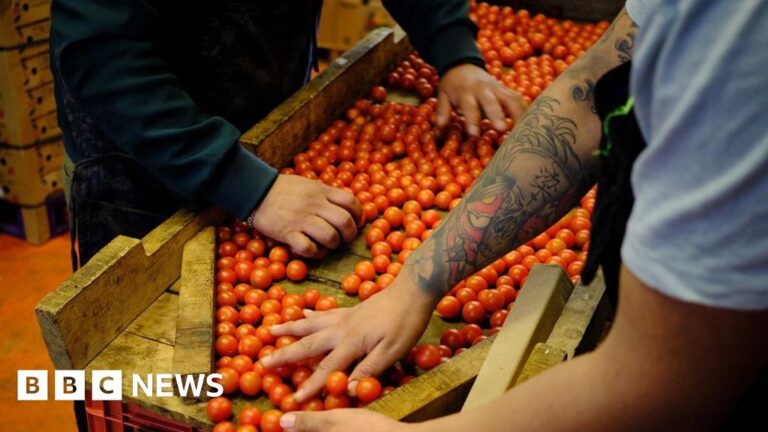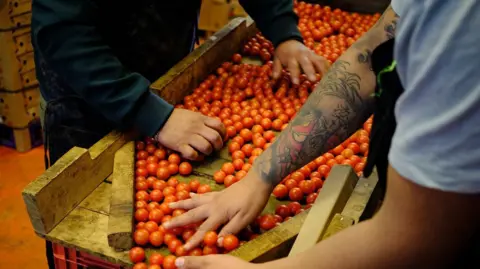 Getty Images
Getty ImagesBusiness leaders around the globe have woken up to the reality of steeper duties on exports to the US market, following President Donald Trump’s new order on tariffs on Thursday night.
In an executive order, President Trump imposed new tariff rates on countries that failed to reach updated trade agreements with the US. Earlier in the week, he outlined a new framework for deals with nations that successfully negotiated revised terms.
Trump’s move has now reshaped America’s trading relationships worldwide with new tariffs on more than 90 countries.
Here’s what some of the business leaders have told the BBC about what this means for them.
Mexico
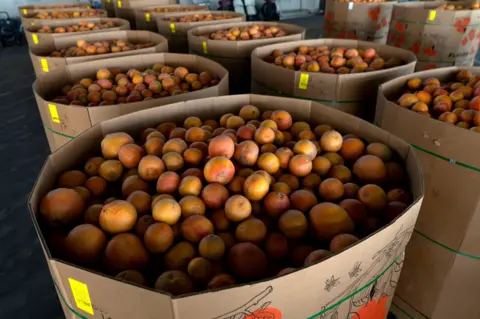 Getty Images
Getty ImagesWhile the White House raised tariffs on Canada from 25% to 35%, its other major North American trading partner, Mexico, got a 90-day reprieve, temporarily halting new duties.
Jaime Chamberlain, president of fruit and vegetable company Chamberlain Distributing in Nogales, Arizona, says his company imports millions of boxes of produce from Mexico each year.
“We are actually very fortunate that the Mexican negotiators along with the US negotiators are keeping calm and keeping cool heads,” he told BBC Radio 4’s Today programme. “Both countries really don’t want to get this wrong.
“And if it takes 90 more days to get it right I think it’s very worthwhile.”
But in the absence of a deal, there’s still huge uncertainty about what might happen once that 90-day extension is up.
“I think in the most extreme cases, many farmers would just stop farming for the export market,” Chamberlain said. “It would be very difficult for the importers of record like myself to continue to pay those duties for a long period of time.”
Thailand
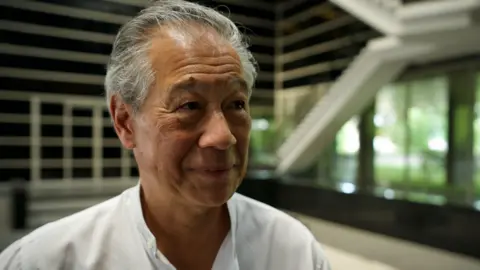 BBC/ Lulu Luo
BBC/ Lulu LuoThailand, which was initially staring at the possibility of a 36% levy, secured a deal to reduce the tariffs to 19%.
Richard Han, CEO of Hana Microelectronics – one of the country’s largest contract manufacturers – recalled his shock at Trump’s initial announcement in April.
“I remember waking up in the morning. It was quite early, and seeing him standing there on the White House lawn with his board. I thought: ‘Did I see that right? 36%? How could it be?'” he said.
But he thinks his business, which makes high-tech goods such as printed circuit boards, integrated circuits, RFID tags for pricing, can survive under the new lower-tariff deal.
“If all of us in this region end up with around 20% our buyers won’t seek alternative suppliers – it will just be a tax, like VAT [value-added tax], for US consumers,” Han said.
Italy
European leaders struck a deal, holding tariffs for most goods at 15% after Trump initially threatened a rate double that.
But that’s still a substantial hike from the former average rate of 4.8%.
According to the Italian Institute of International Political Studies, the agricultural, pharmaceutical and automotive sectors are likely to be hit hardest, with the country’s gross domestic product (GDP) projected to dip by 0.2%.
Cristiano Fini of the Italian Confederation of Farmers said the deal with the US felt more like “a surrender” than an agreement.
Several Italian trade associations are now already clamouring for compensation from the European Union to offset projected losses.
Brazil
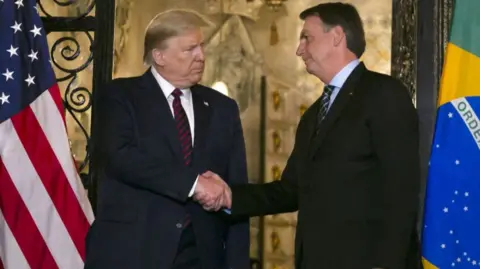 Getty Images
Getty ImagesIf the EU deal managed to blunt the worst effects of the tariffs, Brazil saw its fortunes reverse.
Trump initially announced a 10% rate, but on Wednesday he raised that figure to 50%, accusing President Luiz Inacio Lula da Silva of unfairly attacking US tech companies and calling the prosecution of former President Jair Bolsonaro for attempting a coup a “witch hunt”.
However the higher tariff comes with some exemptions, for instance for orange juice and commercial aircraft.
But other products are expected to face sharp price increases.
Cecafé, Brazil’s coffee exporters’ council, said the impact on Brazilian roasters and exporters will be “significant”, and warned American coffee drinkers to brace for price hikes.
Brazilian producers and exporters are working on contingency plans.
But Cecafé said it won’t be easy to find other markets for the 8.1m tonnes of coffee currently exported to the US. New markets are opening in Asia and the Middle East – however according to Cecafé they won’t be able to absorb all of the potential US shortfall.
Switzerland
Switzerland, once optimistic about reaching a modest 10% rate, was instead hit with a 39% tariff – the highest in Europe.
Just weeks ago, Switzerland’s president Karin Keller-Sutter had hinted that an agreement on a 10% rate might be possible.
The sudden hike has now shocked the country, as tariffs could seriously affect companies that produce pharmaceuticals, jewellery, and machine tools.
‘With its unilateral tariff increases on Swiss industrial products, the US government is sending a clear protectionist signal,” machine tool industry organisation Swissmechanic said in a statement.
“The government must now act with clarity and confidence – and make determined use of the existing window of opportunity for negotiations with the US.”
 Getty Images
Getty ImagesIndia
India was slapped with a 25% tariff with one additional footnote – Trump has threatened to impose an unspecified penalty over India’s business dealings with Russia.
India is currently among the largest buyers of Russian oil, and Trump is using tariffs as leverage to pressure Moscow over the war in Ukraine.
Aurobindo Nayak, who runs CI Ltd, a large tea exporter in Kolkata, says US consumers will ultimately pay the price.
He told the BBC’s World Business Report: “We will definitely bear the brunt. But I think the people who are really going to be hit hard are the American consumers themselves.
“To choose to tax tea in the United States is only going to have an inflationary effect. Assam tea has a lot of character, it is liked by the American consumers. Darjeeling tea is a specialty tea, it’s not grown anywhere else. Consumption in the US is growing.”
 Getty Images
Getty ImagesLaos
One of the steepest tariff rates – 40% – has been imposed on Laos in south-east Asia.
“We are not very happy with the tariff… Laos is a very small country,” said Xaybandith Rasphone, co-founder of sports marketing agency MKGT, and vice-president of the Lao national chamber of commerce. “Laos exports to the US only agricultural products, garments, juice and so on.”
Rasphone told the BBC World Service programme Newsday that 60 companies operating in those sectors collectively employing nearly 60,000 people could be affected.
“Indirect jobs could be affected as well,” he said, noting that the overall effect on the country’s economy could be substantial.
Canada
As mentioned, tariffs on are now 35%, although most goods will avoid the increased costs because they are currently exempted under an existing North American trade treaty.
David Hope is the finance vice president at Hope Aero, a Canadian company that specialises in the maintenance of aircraft components.
He said he “rolled his eyes” when he learned of Trump’s latest tariffs.
Even though most of their clients are not in the US, Mr Hope explained how the integrated nature of the supply chain means their costs are still likely going up.
Many of the parts the company uses come from the US, and he said he expects the vendors to soon raise their prices.
“I’ve already got whispers regarding one of my major vendors that there’s going to be a blanket 10% increase coming down the pipe,” he said.
Aircraft parts are made mostly of steel and aluminium – two materials under 50% tariffs.
“Steel and aluminium are becoming more expensive in the US, so they’re going to pass [those costs] right along,” he said.
With reporting by Laura Gozzi in Rome, Jonathan Head in Bangkok, Ione Wells in São Paulo, Imogen Foulkes in Geneva and Ali Abbas Ahmadi in Toronto
